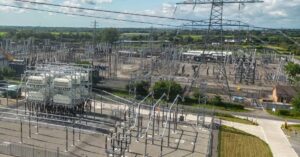

Accelerating the connection of wind power in New York State with modular power flow control
June 15, 2023
Smart Wires today announced results from a network study which validates the capabilities of modular power flow control to accelerate the integration of renewable energy across the state. The study focused on generation pockets with high curtailment and demonstrated that this technology can potentially deliver 300 additional megawatts (MW) of extra capacity and provide an estimated $576 M avoided curtailment savings over 15 years, with distributed deployments across five circuits. The study was completed with project partners Right Analytics, and it was funded through the New York State Energy Research and Development Authority’s (NYSERDA’s) High Performing Grid program for projects that promote grid modernization and enhance electric grid performance.
The electric power system of New York State is undergoing a phase of transition from a fossil fuel powered grid to a clean, renewable-powered system. The state’s Climate Leadership and Community Protection Act (CLCPA) calls for 100% emissions-free electricity sector by 2040; and 70% renewable energy by 2030, which is driving the modernization of the electric grid. Grid enhancing technologies that optimize use of the existing grid can accelerate the integration of renewable energy, and thus have a critical role to play in this transition.
With most of the wind generation projects in the existing interconnection queue due to connect by 2025, this study is timely. The comprehensive study conducted involved assessing the wind generation queue and its impact on the grid, developing modular power flow control solutions to resolve congestion, and completing an economic assessment.
The areas of the grid with the highest forecast congestion were identified, and several locations were selected as the optimal siting for modular power flow control technology (MPFC). Multiple scenarios were considered in the analysis to account for a variety of future network needs. The results showed that with a few deployments, modular power flow control can unlock over 300 MW of spare capacity on the existing grid to support the on-time integration of renewables currently in the queue.
“This study is a great example of how collaboration between R&D, utilities and industry can help advance grid modernization efforts by validating the potential of digital grid technologies to fast track the connection of renewables and deliver real benefits to consumers in the near-term,” said Joaquin Peirano, General Manager – Americas at Smart Wires. “SmartValve™ harnesses the power of silicon and software to pave the way forward for power flow control technologies, solving critical grid challenges by using the existing grid more efficiently.”
Delivering this capacity on time provides greater access to clean, reliable affordable electricity to consumers across the state with potential cost savings of $576 million is due to the avoided curtailment of wind generation from the use of MPFC to balance power flows across circuits. This cost savings figure was calculated for a 15-year period for the purpose of this study, but MPFC devices have a significantly longer asset lifetime in practice. Further cost savings are anticipated due to the reduced production and CO2 costs associated with a higher share of renewables in the energy mix. The MPFC deployments could also support more efficient use of new or upgraded infrastructure by providing greater control of power flows to the system operators.
“This project perfectly showcases the “operational benefits” and “economic values” of grid enhancing technologies in modernized power systems with high penetration of renewables” said Saman Babaei, Director of Power Systems at Right Analytics LLC.
The study results provide a sample of what is possible to achieve both in the state and further afield using modular power flow control to solve critical grid challenges. This move toward a modular, digital power flow control offering eliminates many disadvantages of previous PFC devices such as the requirement for a large amount of substation space and works, long delivery and installation times, complex permitting, and the lack of flexibility to adapt or relocate the solution over time. It provides a flexible and scalable technology with high reliability, faster delivery and installation, with multiple network applications.
The opinions expressed here do not necessarily reflect those of NYSERDA or the State of New York.
For press related purposes, please contact us at marketing@smartwires.com.
Dive deeper into related content
Explore our products and services
Talk to our experts


